.
Timbrell’s Yard
painting Bradford on Avon Museum, Wiltshire
.

.
Not long after the Museum opened in 1990, an art dealer offered for sale an oil painting that was obviously of a corner of Bradford on Avon that had changed a good deal. The price was steep, but it wasn’t something that the Museum could let pass by. The cost was partially met by a grant from a fund that was administered by the victoria & Albert Museum in London and the rest was made up by donations from Bradford Town Council and from numerous individuals.
The painting, which is quite large and in good condition following a thorough restoration, depicts the space in the centre of the town that is now the St Margaret’s carpark and the building that surrounded it. These are incidental, as the real subject was three prize greyhounds and a couple of other dogs. It has been attributed to the journeyman artist Samuel Spode (1798-1872), who is known for other sporting paintings, one of which also features greyhounds in Wiltshire, Hare coursing at Stonehenge, dated 1845.
The historical interest lies in the buildings which were involved in Bradford’s long-gone woollen cloth industry. On the left is the façade of what was then, in around 1850, a dyehouse and is now St Margaret’s Hall. Outside is a steaming vat in which balls of the blue plant-based dye indigo were boiled; blue balls are lined up on the table in the entrance. Wool could be dyed “in the wool”, ie unwoven, or “in the piece” for finished woven cloth. The buildings in the centre and on the right were also used in the processing, but were demolished in the 1960s. Under a lean-to roof are two wagons that are laden with woolsacks and to the left scales for weighing materials.
In the background is a representation of the ranks of houses on the hillside and, on the right, the silhouette of another woollen cloth factory, the old Abbey Mill that was mostly replaced by a new building in 1875.
At the time when the picture was painted the dyeworks belonged to Charles Timbrell and presumably he commissioned the portrait of his dogs.
The public house and hotel now called Timbrell’s Yard takes its name from the painting. That building was formerly St Margaret’s House and belonged, with the dyeworks next door, to Charles Timbrell.



